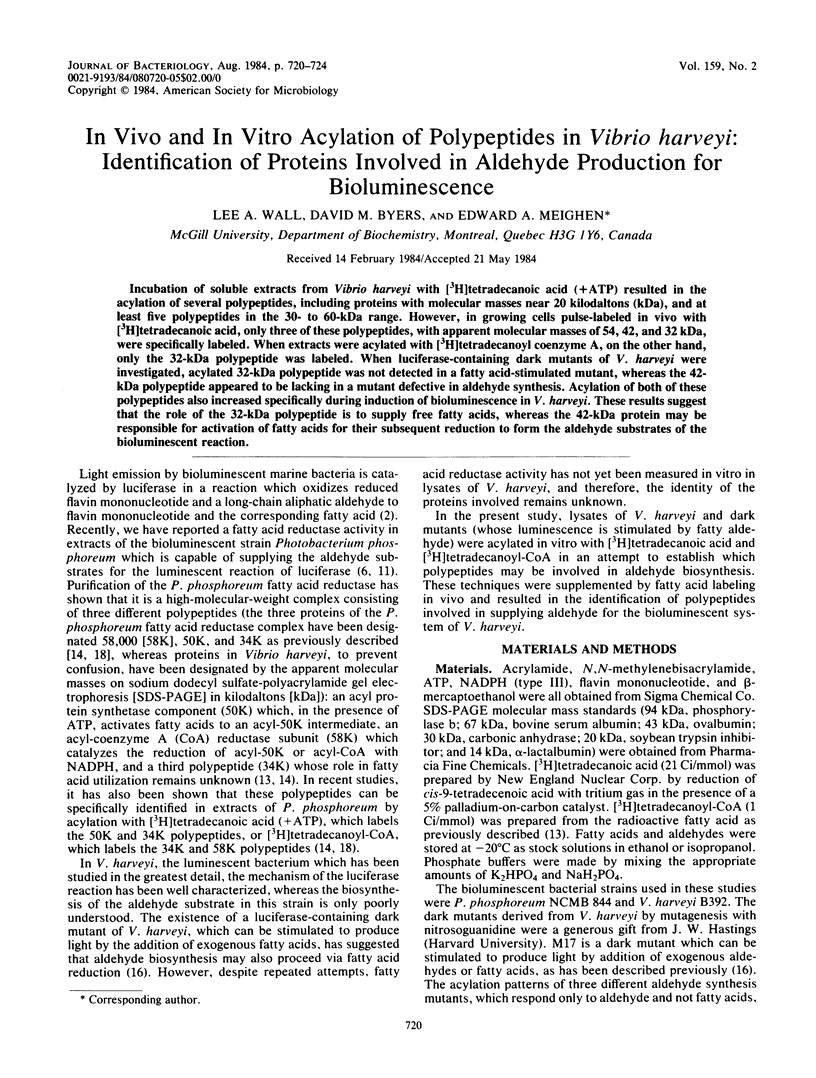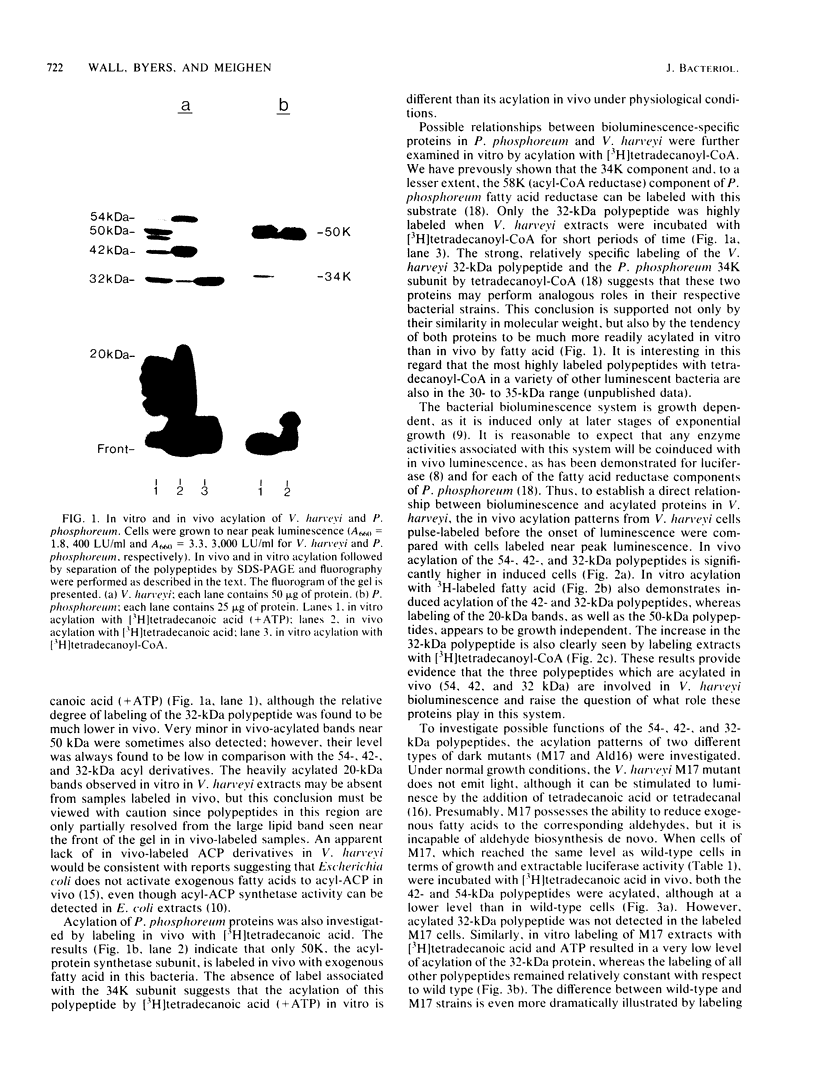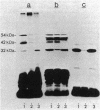Abstract
Incubation of soluble extracts from Vibrio harveyi with [3H]tetradecanoic acid (+ ATP) resulted in the acylation of several polypeptides, including proteins with molecular masses near 20 kilodaltons (kDa), and at least five polypeptides in the 30- to 60-kDa range. However, in growing cells pulse-labeled in vivo with [3H]tetradecanoic acid, only three of these polypeptides, with apparent molecular masses of 54, 42, and 32 kDa, were specifically labeled. When extracts were acylated with [3H] tetradecanoyl coenzyme A, on the other hand, only the 32-kDa polypeptide was labeled. When luciferase-containing dark mutants of V. harveyi were investigated, acylated 32-kDa polypeptide was not detected in a fatty acid-stimulated mutant, whereas the 42-kDa polypeptide appeared to be lacking in a mutant defective in aldehyde synthesis. Acylation of both of these polypeptides also increased specifically during induction of bioluminescence in V. harveyi. These results suggest that the role of the 32-kDa polypeptide is to supply free fatty acids, whereas the 42-kDa protein may be responsible for activation of fatty acids for their subsequent reduction to form the aldehyde substrates of the bioluminescent reaction.
Full text
PDF




Images in this article
Selected References
These references are in PubMed. This may not be the complete list of references from this article.
- Bradford M. M. A rapid and sensitive method for the quantitation of microgram quantities of protein utilizing the principle of protein-dye binding. Anal Biochem. 1976 May 7;72:248–254. doi: 10.1006/abio.1976.9999. [DOI] [PubMed] [Google Scholar]
- Dunn D. K., Michaliszyn G. A., Bogacki I. G., Meighen E. A. Conversion of aldehyde to acid in the bacterial bioluminescent reaction. Biochemistry. 1973 Nov 20;12(24):4911–4918. doi: 10.1021/bi00748a016. [DOI] [PubMed] [Google Scholar]
- Gunsalus-Miguel A., Meighen E. A., Nicoli M. Z., Nealson K. H., Hastings J. W. Purification and properties of bacterial luciferases. J Biol Chem. 1972 Jan 25;247(2):398–404. [PubMed] [Google Scholar]
- Laemmli U. K. Cleavage of structural proteins during the assembly of the head of bacteriophage T4. Nature. 1970 Aug 15;227(5259):680–685. doi: 10.1038/227680a0. [DOI] [PubMed] [Google Scholar]
- Meighen E. A., Bartlet I. Complementation of subunits from different bacterial luciferases. Evidence for the role of the beta subunit in the bioluminescent mechanism. J Biol Chem. 1980 Dec 10;255(23):11181–11187. [PubMed] [Google Scholar]
- Meighen E. A. Biosynthesis of aliphatic aldehydes for the bacterial bioluminescent reaction: stimulation by ATP and NADPH. Biochem Biophys Res Commun. 1979 Apr 27;87(4):1080–1086. doi: 10.1016/s0006-291x(79)80018-2. [DOI] [PubMed] [Google Scholar]
- Michaliszyn G. A., Meighen E. A. Induced polypeptide synthesis during the development of bacterial bioluminescence. J Biol Chem. 1976 May 10;251(9):2541–2549. [PubMed] [Google Scholar]
- Nealson K. H., Platt T., Hastings J. W. Cellular control of the synthesis and activity of the bacterial luminescent system. J Bacteriol. 1970 Oct;104(1):313–322. doi: 10.1128/jb.104.1.313-322.1970. [DOI] [PMC free article] [PubMed] [Google Scholar]
- Ray T. K., Cronan J. E., Jr Activation of long chain fatty acids with acyl carrier protein: demonstration of a new enzyme, acyl-acyl carrier protein synthetase, in Escherichia coli. Proc Natl Acad Sci U S A. 1976 Dec;73(12):4374–4378. doi: 10.1073/pnas.73.12.4374. [DOI] [PMC free article] [PubMed] [Google Scholar]
- Riendeau D., Meighen E. Evidence for a fatty acid reductase catalyzing the synthesis of aldehydes for the bacterial bioluminescent reaction. Resolution from luciferase and dependence on fatty acids. J Biol Chem. 1979 Aug 25;254(16):7488–7490. [PubMed] [Google Scholar]
- Rock C. O., Cronan J. E., Jr Re-evaluation of the solution structure of acyl carrier protein. J Biol Chem. 1979 Oct 10;254(19):9778–9785. [PubMed] [Google Scholar]
- Rodriguez A., Riendeau D., Meighen E. Purification of the acyl coenzyme A reductase component from a complex responsible for the reduction of fatty acids in bioluminescent bacteria. Properties and acyltransferase activity. J Biol Chem. 1983 Apr 25;258(8):5233–5237. [PubMed] [Google Scholar]
- Silbert D. F., Ruch F., Vagelos P. R. Fatty acid replacements in a fatty acid auxotroph of Escherichia coli. J Bacteriol. 1968 May;95(5):1658–1665. doi: 10.1128/jb.95.5.1658-1665.1968. [DOI] [PMC free article] [PubMed] [Google Scholar]
- Ulitzur S., Hastings J. W. Myristic acid stimulation of bacterial bioluminescence in "aldehyde" mutants. Proc Natl Acad Sci U S A. 1978 Jan;75(1):266–269. doi: 10.1073/pnas.75.1.266. [DOI] [PMC free article] [PubMed] [Google Scholar]
- Wall L., Rodriquez A., Meighen E. Differential acylation in vitro with tetradecanoyl coenzyme A and tetradecanoic acid (+ATP) of three polypeptides shown to have induced synthesis in Photobacterium phosphoreum. J Biol Chem. 1984 Feb 10;259(3):1409–1414. [PubMed] [Google Scholar]





